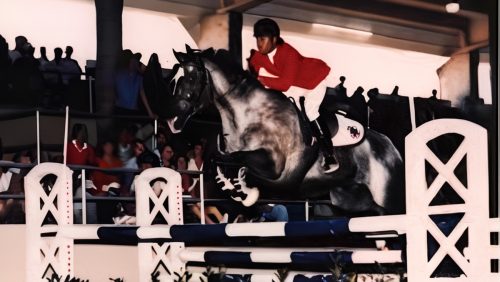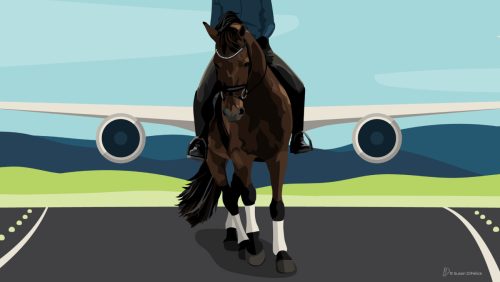Everyone starts their young horses differently. Some start them as 2-year-olds and some wait until they are 4. Some start them through long-lining and some start them through lunging. Who is to say what the “correct way” is. In my opinion there are multiple correct ways, and every person must find what works for them and the horse.
I start all of my young horses in a rope halter and begin with groundwork and then lunging. I love the rope halters; they allow me to have control and respect from the horse while at the same time not having to “yank” with a chain over their nose or a bit in their mouth. I was introduced to the rope halters about 10 years ago and while at first I didn’t really think they would make much difference or be useful, I quickly learned differently. With two knots strategically placed on the noseband of the halter, they give you slightly more control and teach the horse to respect the halter. Plus, I can use one halter on any horse because it can be tied to the correct size.
Working with so many stallions, it is very important that they respect me, but also trust me at the same time. When I lead them around, I always do so with a chain over their nose to ensure both mine and their safety; however, this chain is just there if I need it. I do not think a chain should be overused or abused because then the horse becomes immune and less responsive.
As a rider, I want my horse to be very responsive so that if I say “whoa,” they say “how fast?” Or if I take a feel of the reins, I want them to accept it instead of locking against me. In talking with the best handlers, they will tell you they do not like to use chains because they want to teach the horse to be “light” in their hand, so when they say “stop,” the horse does so immediately.
The horse’s mouth is a fragile thing and needless yanking and jerking makes it tough and unresponsive. I met an accomplished German rider a few weeks back who told me that they do not put a bit in the horse’s mouth until it is a 3-year-old because they don’t want to ruin the mouth. It’s for the same reason that I don’t start working my horses with a bit in their mouth. Undoubtedly, when a young horse is first put into work they are going to be confused and a bit nervous, so they will then pull against you. If you have a bit in, it will cut into their mouth. This in turn makes them more nervous, and it is a domino effect.
When I start a young horse I have a series of steps that I like to build on; if the horse has not mastered the first step they cannot go onto the second step, and so on and so forth. This is for their confidence and safety as well as my own. Starting young horses can be dangerous, but if you take your time, and have confidence and patience it can greatly lessen those risks.
Starting young horses is not for everyone and we all have to recognize our limits; it is not smart to do something that makes you nervous or is beyond your experience level. If someone were to ask what traits I believe are important in a young horse starter I would answer: patience, compassion, firmness, confidence, and a sense of timing. A sense of timing means that you know when to correct the horse, if you correct the horse too late, they do not understand what they are being corrected for; correct the horse before it makes a mistake.
ADVERTISEMENT
When I start my young horses, I do so with verbal noises and words. People think I am crazy because I talk to my horses, but they listen and learn what these words or noises mean. When I get on them they will have no idea what legging them forward means, but if I can put it with a noise they recognize, it will make the process a lot easier and less confusing for the horse. The same goes with “whoa,” which is very important. When when I say it, my horses know that it means “stop, right now!”
I also roll my tongue in a kind of purring noise to ask them to slow down. This drives my sister nuts because she cannot make the noise, and when she is riding a young horse I will make the noise when they need to slow down, and you can visibly see them slow down. These noises also help my horses to relax and be more confident because they are familiar to them.
All of these steps and processes help me when I go to get on my young horses for the first time. I will not get on them till they are ready, and I also will not get on them alone. I always make sure someone is in the ring with me in case something was to happen. I could just hop on them and ride out the bucks but I don’t think that helps the horse in the long run; it has to be a peaceful and safe experience for them.
The first time I get on a young horse it is in the rope halter and rope; depending upon the horse sometimes it is bareback and sometimes it is with a saddle. When the horse is nervous about me stepping into the stirrup because they feel the saddle pulling on them, I will sit on them and walk them around bareback before putting the saddle back on. I have heard people tell me I am crazy to start them with a rope halter instead of a bridle, but I feel completely confident and in control. Plus I am saving my horse’s mouth in case I do need to pull on them. What’s more, I want my horses to move off my legs and seat, not just my hands. After about three or four rides when they are walking and trotting around the ring, in circles and steering off my legs, I will then put a bridle on. I do my homework, my horses know my voice and they respect me, and if I keep their focus on me, they will keep their minds on me, waiting for my next question.
There is always that chance that the horse will take off bucking, but I am prepared for this and always pay attention to my horse’s body language and attitude because he will tell me what he is going to do before he does it. I don’t think my way will work for everyone but it has worked for me so far, and I will continue to develop it as I learn and further my education. Horses are my greatest teachers and with each one I start I learn something new.
Chronicle blogger Taylor Flury rides out of her family’s AliBoo Farm in Minooka, Ill., and competes primarily in the jumpers. She also runs AliBoo’s breeding program. Flury’s top mount is the U.S.-bred Role Model (Roc USA—Darling Devil), who claimed U.S. Equestrian Federation Horse of the Year titles in 2011 and 2012 in the 5- and 6-Year-Old Jumper divisions and just won her first grand prix.














